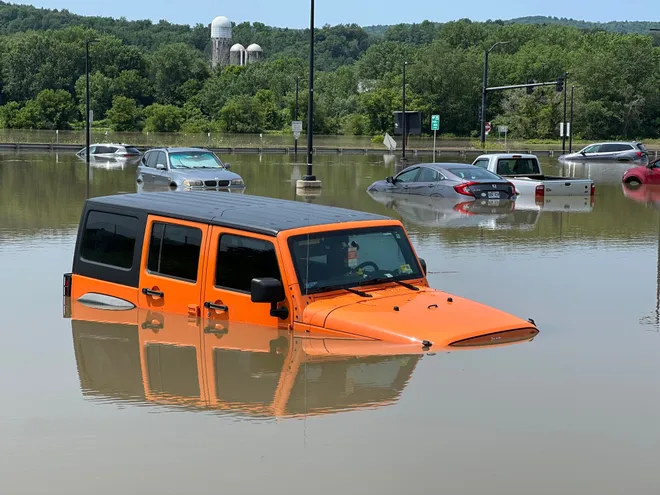Does flood insurance cover ... this? A comprehensive guide to basement, rain, storm damage.
This summer has been one of flash flooding – New England, the southern High Plains, mid-South, Pennsylvania and more areas of the U.S. have seen dangerous flood conditions already this summer.
These heavy rainfall events could increase by 52% in the Northeast by the end of the century because of climate change, researchers previously told USA TODAY.
Looking to stay prepared? The Federal Emergency Management Agency has a public flood insurance policy, the National Flood InsuranceProgram but there are also many private market options to choose from. Here’s some basic information about coverage details.

What does flood insurance cover?
Flood insurance is separate from homeowners insurance and covers physical damage directly caused by a flood.
Lower your auto insurance costs: Find the best car insurance of 2023
Policies and coverage options vary based on the insurance carrier, although there are two different types of coverage available under NFIP – building and contents. Here’s what building flood insurance covers, according to NFIP:
- Electrical and plumbing systems
- Furnaces and water heaters
- Refrigerators, cooking stoves, and built-in appliances
- Permanently installed carpeting
- Permanently installed cabinets, paneling, and bookcases
- Window blinds
- Foundation walls, anchorage systems and staircases
- Detached garages
- Fuel tanks, well water tanks and pumps and solar energy equipment
Here’s what contents coverage protects:
- Personal belongings such as clothing, furniture and electronic equipment
- Curtains
- Washer and dryer
- Portable and window air conditioners
- Microwave oven
- Carpets not included in building coverage
- Valuable items up to $2,500
Damage that isn’t the direct result of flooding will not be covered by flood insurance. Here are a few examples of items that aren’t covered by flood insurance:
- Temporary housing and expenses incurred during building repairs
- Property outside of the insured building
- Financial losses due to business interruption
- Cash
- Precious metals
- Stock certificates and other valuable papers
- Cars
- Personal property kept in basements
Flash flood warnings:Here's what to know about this deadly weather hazard
Does flood insurance cover basements?
In the NFIP’s eyes, a basement is “any area of a building with a floor that is below ground level on all sides.” The NFIP’s standard policy covers cleanup and basement items that are installed or connected to a power source. This may include central air conditioners, fuel tanks, furnaces, water heaters electrical outlets, elevators, and stairways, among other items. You can view the full list here.
Does flood insurance cover rain damage?
According to FEMA, if river overflow or rain causes flash flooding that enters the home, it’s likely covered because it’s known as a “direct result of flooding.” Flash flooding occurs when heavy rainfall surpasses the ground’s ability to absorb it. It can also occur when enough water accumulates for streams to overtop their banks.
If the water comes through a covered structure or a damaged roof, it’s known as “wind-driven rain” or “water damage as a result of wind damage” and is likely not covered by your flood insurance, FEMA says.
Does flood insurance cover storm surge?
Yes – NFIP policies cover damage to your home caused by storm surge. A storm surge is when a massive amount of water builds up and comes ashore during a hurricane.
Does flood insurance cover burst pipes?
Burst pipes are typically covered by homeowners insurance, not flood insurance. You’ll want to check with your individual policy, though – FEMA states that NFIP covers plumbing systems. But if they burst of their own accord or without being impacted by rain, they likely won’t be covered by flood insurance.
Does flood insurance cover sewer backup?
Sewer backup is covered only if it's a direct result of flooding, NFIP says.
Do I need flood insurance?
Flood insurance is not federally regulated, though many lenders require property owners to buy flood insurance at closing. Homes and businesses with a government-backed mortgage within FEMA’s “100-year flood zone” are required to have flood insurance.
There are several ways to assess your property’s risk. DJ McClure, vice president of business development at National Flood Experts, recommends looking for your property on the map to understand the proposed flood elevation. You can also do this by looking at Google Earth or by purchasing an elevation certificate, which FEMA says documents your building’s elevation to determine flood risk and insurance cost.
“If buying a property, it's good practice to talk to some neighboring properties to understand if any nearby bodies of water or potential flood sources have caused flooding issues in the past,” McClure wrote in an email to USA TODAY.
According to McClure, qualified insurance brokers can aid in lowering flood insurance costs – they’ll know how to properly evaluate the building and seek out an engineering-based consulting service if needed.
When is hurricane season?:The information you need to stay prepared
Just Curious for more? We've got you covered
USA TODAY is exploring the questions you and others ask every day. From "When is tornado season?" to "Why is yawning contagious?" to "Is Uber safe?", we're striving to find answers to the most common questions you ask every day. Head to our Just Curious section to see what else we can answer for you.
Disclaimer: The copyright of this article belongs to the original author. Reposting this article is solely for the purpose of information dissemination and does not constitute any investment advice. If there is any infringement, please contact us immediately. We will make corrections or deletions as necessary. Thank you.







